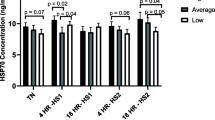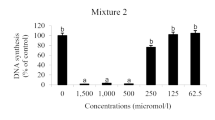Abstract
This study was carried out to ascertain the effects of intense high environmental temperatures (HET) on lymphocyte functions in periparturient dairy cows. The study was undertaken from the beginning of March through the end of July 2003 in a commercial dairy unit located approximately 40 km north of Rome. Thirty-four Holstein cows were utilised in the study. Twenty-two of these cows gave birth in spring (SP cows), from 28 March to 30 April. The remaining 12 cows gave birth in summer (SU cows), between 15 June and 2 July. The two groups of cows were balanced for parity and were fed the same rations. Blood samples were taken 4, 3, 2 and 1 week before calving, and 1, 2 and 4 weeks after calving, in order to evaluate peripheral blood mononuclear cell (PBMC) function in vitro, and to determine plasma cortisol concentrations. After isolation, the PBMC were stimulated with mitogens and their response in terms of DNA synthesis and IgM secretion was measured. During spring, either the day (9–20 h) or the night (21–8 h) temperature humidity index (THI) was below the upper critical THI (72) established for dairy cows. During summer, the mean daily THI values were 79.5±2.9 during the day and 70.1±4.7 during the night. Furthermore, during summer, three heat waves (a period of at least 3 consecutive days during which there were less than 10 recovery hours) occurred. Recovery hours were intended hours with a THI below 72. The first heat wave lasted 5 days, the second 6 days, and the third 15 days. Compared to the SP cows, over the entire periparturient period the extent of DNA synthesis and IgM secretion levels were lower (P ranging from <0.01 to 0.0001) and higher (P<0.01) respectively, in the SU cows. Before calving, the SU cows also presented higher (P<0.01) concentrations of plasma cortisol compared to the SP cows. This study indicates that the effects of HET on the immune response depend on the specific immune function under consideration, and that neuroendocrinal changes due to HET may play a role in the perturbation of immune functions.



Similar content being viewed by others
References
Abilay TA, Johnson HD, Madan M (1975) Influence of environmental heat on peripheral plasma progesterone and cortisol during the bovine estrous cycle. J Dairy Sci 58:1836–1840
Agarwal SK, Marshall GD Jr (2001) Dexamethasone promotes type 2 cytokine production primarily through inhibition of type 1 cytokines. J Interferon Cytokine Res 21:147–155
Amat J, Torres A (1993) Circannual rhythm in the effects of stress on the humoral immune response of the rat. Neurosci Lett 160:190–192
Beard CW, Mitchell BW (1987) Influence of environmental temperatures on the serologic responses of broiler chickens to inactivated and viable Newcastle disease vaccines. Avian Dis 31:321–326
Boneberg EM, Hartung T (2003) Febrile temperatures attenuate IL-1 beta release by inhibiting proteolytic processing of the proform and influence Th1/Th2 balance by favoring Th2 cytokines. J Immunol 171:664–668
Boom WH (1996) The role of T-cell subsets in Mycobacterium tuberculosis infection. Infect Agents Dis 5:73–81
Cook NB, Bennett TB, Emery KM, Nordlund KV (2002) Monitoring nonlactating cow intramammary infection dynamics using DHI somatic cell count data. J Dairy Sci 85:1119–1126
Elenkov IJ, Chrousos GP (1999) Stress hormones, Th1/Th2 patterns, pro/anti-inflammatory cytokines and susceptibility to disease. Trends Endrocr Metab 10:359–368
Elvinger F, Hansen PJ, Natzke RP (1991) Modulation of function of bovine polimorphonuclear leukocytes and lymphocytes by high temperature in vitro and in vivo. Am J Vet Res 52:1692–1698
Franchimont D, Louis E, Dewe W, Martens H, Vrindts-Gevaert Y, de Groote D, Belaiche J, Greenen V (1998) Effects of dexamethasone on the profile of cytokine secretion in human whole blood cell cultures. Regl Pept 73:59–65
Graham DA, Mawhinney KA, Adair BM, Merza M (1998a) Testing of bovine sera by ELISA for IgG, IgM and IgA rheumatoid factors. Vet Immunol Immunopathol 61:239–250
Graham DA, McShane J, Mawhinney KA, McLaren IE, Adair BM, Merza M (1998b) Evaluation of a single dilution ELISA system for detection of seroconversion to bovine viral diarrhoea virus, bovine respiratory syncytial virus, parainfluenza-3 virus, and infectious bovine rhinotracheitis virus: comparison with testing by virus neutralization and hemagglutination inhibition. J Vet Diagn Invest 10:43–48
Hahn GL, Mader TL, Harrington JA, Nienaber JA, Frank KL (2002) Living with climatic variability and potential global change: climatological analyses of impacts on livestock performance. In: Proceedings of the 16th international congress on biometeorology, Kansas City, 27 October–1 November 2002, pp 45–49
Johnson HD (1987) Bioclimate effects on growth, reproduction and milk production. In: Johnson HD (ed) Bioclimatology and the adaptation of livestock. Elsevier, Amsterdam, pp 35–57
Kamwanja LA, Chase CC, Gutierrez JA, Guerriero V, Olson TA, Hammond AC, Hansen PJ (1994) Responses of bovine lymphocytes to heat shock as modified by breed and antioxidant status. J Anim Sci 72:438–444
Kelley KW (1982) Immunobiology of domestic animals as affected by hot and cold weather. In: Proceedings of the second international livestock environment symposium. ASAE Publication No. 3–82, St. Joseph, Michigan, pp 470–483
Kelley KW, Greenfield RE, Evermann JF, Parish SM, Perryman LE (1982a) Delayed-type hypersensitivity, contact sensitivity, and phytohemagglutinin skin-test responses of heat- and cold-stressed calves. Am J Vet Res 43:775–779
Kelley KW, Osborne CA, Evermann JF, Parish SM, Gaskins CT (1982b) Effects of chronic heat and cold stressors on plasma immunoglobulin and mitogen-induced blastogenesis in calves. J Dairy Sci 65:1514–1528
Kok FW, Heijnen CJ, Bruijn JA, Westenberg HGM, van Ree JM (1995) Immunoglobulin production in vitro in major depression: a pilot study on the modulating action of endogenous cortisol. Biol Psychiatry 38:217–226
Lacetera N, Bernabucci U, Ronchi B, Scalia D, Nardone A (2002) Moderate summer heat stress does not modify immunological parameters of Holstein dairy cows. Int J Biometeorol 46:33–37
Lacetera N, Scalia D, Franci O, Bernabucci U, Ronchi B, Nardone A (2004) Effects of nonesterified fatty acids on lymphocyte function in dairy heifers. J Dairy Sci 87:1012–1014
MacMurray JP, Barker JP, Armstrong JD, Bozzetti LP, Kuhn IN (1983) Circannual changes in immune function. Life Sci 32:2363–2370
Morse D, DeLorenzo MA, Wilcox CJ, Collier RJ, Natzke RP, Bray DR (1988) Climatic effects on occurrence of clinical mastitis. J Dairy Sci 71:848–853
Moynihan JA (2003) Mechanisms of stress-induced modulation of immunity. Brain Behav Immun 17:S11–S16
Murzenok PP, Netukova NI, Zhytkevitch TI (1997) Ultrastructure and functional state of rabbit lymphoid cells after repeated exposure to lipopolysaccharide and external heating. Arch Immunol Ther Exp (Warsz) 45:301–305
Nakamura H, Seto T, Nagase H, Yoshida M, Dan S, Ogino K (1997) Inhibitory effect of pregnancy on stress-induced immunosuppression through corticotropin releasing hormone (CRH) and dopaminergic systems. J Neuroimmunol 75:1–8
Nardone A (2000) Weather conditions and genetics of breeding systems in the Mediterranean area. In: Enne G, Greppi GF, Licitra G (eds) Proceedings of 35th international symposium of the Società Italiana Progresso Zootecnia, MG Electronic Media and Books, Bergamo, pp 67–91
Nardone A, Lacetera N, Bernabucci U, Ronchi B (1997) Composition of colostrum from dairy heifers exposed to high air temperatures during late pregnancy and the early postpartum period. J Dairy Sci 80:838–844
Regnier JA, Kelley KW (1981) Heat- and cold-stress suppresses in vivo and in vitro cellular immune responses of chickens. Am J Vet Res 42:294–299
Ronchi B, Stradaioli G, Verini Supplizi A, Bernabucci U, Lacetera N, Accorsi PA, Nardone A, Seren E (2001) Influence of heat stress or feed restriction on plasma progesterone, oestradiol–17b, LH, FSH, prolactin and cortisol in Holstein heifers. Liv Prod Sci 68:231–241
SAS User’s Guide (1996) Statistics ver 6.11, SAS Inst, Cary, NC
Silanikove N (2000) Effects of heat stress on the welfare of extensively managed domestic ruminants. Liv Prod Sci 67:1–18
Smith KL, Todhunter DA, Schoenberger PS (1985) Environmental mastitis: cause, prevalence, prevention. J Dairy Sci 68:1531–1553
Soper F, Muscoplat CC, Johnson DW (1978) In vitro stimulation of bovine peripheral blood lymphocytes: analysis of variation of lymphocyte blastogenic response in normal dairy cattle. Am J Vet Res 39:1039–1042
Valtorta SE, Leva PE, Gallardo MR, Scarpati OE (2002) Milk production responses during heat waves events in Argentina. Proceedings of the 16th international congress on biometeorology, Kansas City, 27 October–1 November 2002, 98–101
Waage S, Sviland S, Odegaard SA (1998) Identification of risk factors for clinical mastitis in dairy heifers. J Dairy Sci 81:1275–1284
Webster JI, Tonelli L, Sternberg EM (2002) Neuroendocrine regulation of immunity. Annu Rev Immunol 20:125–163
Welsh MD, Cunningham RT, Corbett DM, Girvin RM, McNair J, Skuce RA, Bryson DG, Pollock JM (2005) Influence of pathological progresion on the balance between cellular and humoral immune responses in bovine tuberculosis. Immunol 114:101–111
WHO briefing note for the fifty-third session of the WHO Regional Committee for Europe. Vienna, Austria, 8–11 September 2003
Wise ME, Armstrong DV, Huber JT, Hunter R, Wiersma F (1988) Hormonal alterations in the lactating dairy cow in response to thermal stress. J Dairy Sci 71:2480–2485
Yeruham I, Elad D, Friedman S, Perl S (2003) Corynebacterium pseudotuberculosis infection in Israeli dairy cattle. Epidemiol Infect 131:947–955
Acknowledgements
This study was financially co-supported by MIUR (PRIN 03 and Special Project FIRB) and Università degli Studi della Tuscia. The authors gratefully acknowledge C. Armeni, C. Bruti, M. Guida, A. Morales and D. Pirazzi for technical help. The study complies with current Italian laws.
Author information
Authors and Affiliations
Corresponding author
Rights and permissions
About this article
Cite this article
Lacetera, N., Bernabucci, U., Scalia, D. et al. Lymphocyte functions in dairy cows in hot environment. Int J Biometeorol 50, 105–110 (2005). https://doi.org/10.1007/s00484-005-0273-3
Received:
Revised:
Accepted:
Published:
Issue Date:
DOI: https://doi.org/10.1007/s00484-005-0273-3




